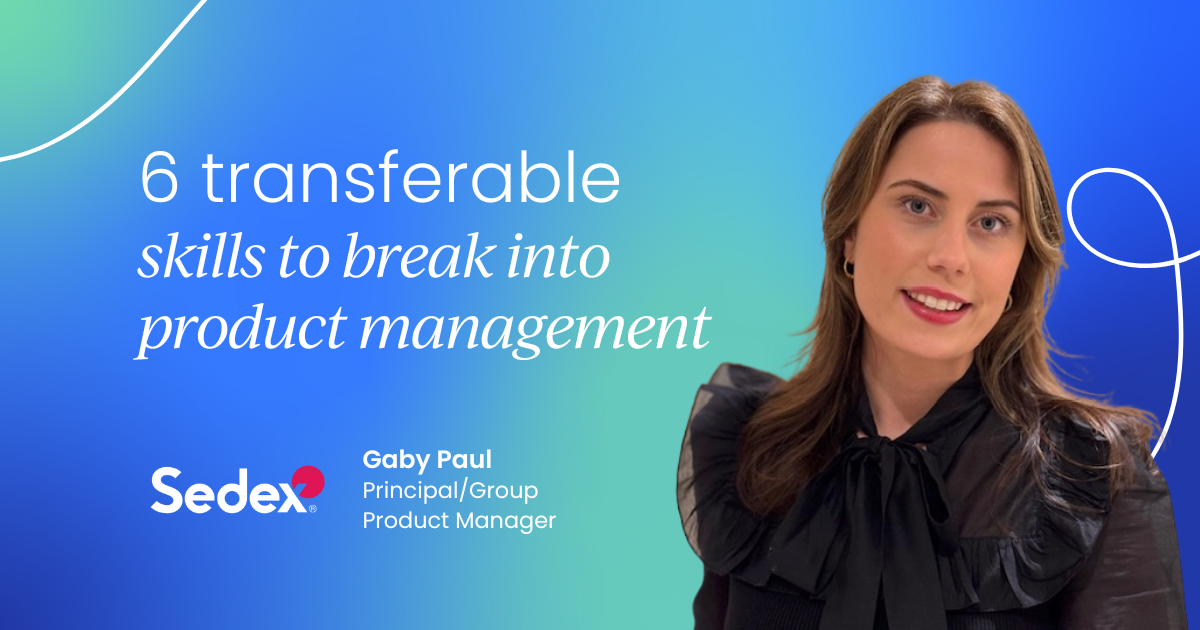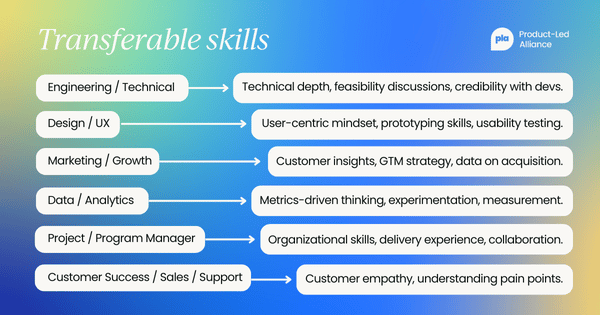TL;DR: Quick career ladder snapshot
- Associate Product Manager – entry-level product role, often via rotational or graduate programs.
- Product Manager – manages a single product or product area.
- Senior Product Manager – handles larger scope and higher-impact initiatives.
- Lead / Group Product Manager – oversees multiple PMs and a broader product portfolio.
- Director of Product Management – leads product strategy for a domain or several product lines.
- Vice President of Product – sets company-wide product strategy and direction.
- Chief Product Officer – executive role leading the entire product organization.
What is a product manager?
A product manager is responsible for the entire product lifecycle. This involves determining the product strategy and vision from ideation to launch and beyond.
The role balances meeting organizational goals alongside market and customer needs. By optimizing the product for the user, PMs aim to also increase monetization, revenue, and retention for the company.
“A product manager identifies a customer’s needs and the overall business objectives required to fulfill those needs. They determine how the product will meet the customer’s expectations, detail what success looks like, and rally the team to bring the vision into reality.”
– Michael Pierce, Director of Product Management at Public Consulting Group.
The core roles and responsibilities
Some key responsibilities of a PM include:
- Shaping and owning the product vision, strategy, and roadmap
- Conducting market and user research
- Prioritizing features in the roadmap and driving continuous enhancement
- Aligning cross-functional teams, to ensure cohesive execution
- Maintaining a delicate balance between business, tech, and customer needs
- Acting both as a strategic architect and key communicator within the organization
Difference between product vs project vs program management
Before we dive into the details of a typical product management career path we need to clear up a common point of confusion.
Project managers and program managers (while often also shortened to PM) are NOT product management roles. For more details on the difference, check out our breakdowns here and here.

PM career levels & progression path
Associate Product Manager
The typical entry-level role in product management is Associate Product Manager (APM). It’s in this role you’ll learn the ropes of product management. APMs do everything a product manager does, but on a smaller scale.
Michael Pierce explains: “You likely won’t own the product roadmap or develop the product strategy yet, but you’ll set priorities for your projects. And although you won’t present product plans across the company, you’ll keep your manager and peers updated.”
In this stage of your career, it’s particularly important to stay flexible and keep learning. Michael’s advice to APMs is: “It’s not about knowing the most, beating everyone, or working 24/7; it’s about learning empathy for the user. You must learn to identify issues and problems with the product.”
Hiring managers typically look for candidates who understand what product management is and show passion and interest for the customer. Some HR departments may prefer marketing experience or some product management experience, but neither is necessary.
Many companies will hire associate product managers straight out of school or college. However, many associate product managers have bachelor's degrees in business, marketing, and computer science.
Skip ahead to learn more about APM programs.
Main duties include:
- Collecting product data
- Completing customer research
- Coordinating with stakeholders
- Developing new product features
Product Manager
The next step in the ladder is becoming a Product Manager, where you’ll be the team's go-to resource and the point person on the product team.
Most PMs have experience before starting the role, but it’s not always direct product management experience. However, you’ll most definitely need some professional experience and evidence of robust communication and collaboration skills.
All that to say, you can transition from another role, such as product marketer, software engineer, or project manager, straight into a product manager role with enough experience and drive.
Michael states: “Product managers will need an understanding of all aspects of the business – including technology, marketing, and business. You’ll need to speak basic product concepts and have an excellent leadership style to motivate others. Being able to understand basic data is also essential.”
Main duties include:
- Creating product planning
- Analyzing product marketing
- Working with engineering
- Defining the product vision

Senior Product Manager
After succeeding as a product manager, there’s a strong likelihood you’ll work as a Senior Product Manager. Almost all senior product managers will have product management experience – including prior experience as an APM or PM.
Although Michael has seen “In some cases, you may land the role if you have substantial professional experience handling data, communicating with large teams, and making significant decisions. However, a senior product manager needs to show mastery of a product manager's communication streams.”
Many Sr. PMs undergo the same duties as earlier roles but with an increased responsibility and work on higher-visibility products. You’ll require stronger product knowledge than before because there’s considerably more responsibility on your shoulders.
You must make hard decisions and high-risk trade-offs between speed-to-market and features when you’re a Sr. PM. You also must lead the team, monitor customer engagement, sell your vision to the leadership team, and collaborate with engineers.
Main duties include:
- Communicating with stakeholders
- Working with senior management
- Analyzing customer feedback
- Creating roadmaps and product plans

Staff / Principal Product Manager (IC track)
Not interested in people management, but still want to progress? The next move in your product management career might be becoming a Principal Product Manager.
(Skip ahead to Group Product Manager if you’d rather learn about the people manager track.)
Principal product managers typically have years of experience overseeing, executing, and owning various product management processes. These include creating product strategies, designing product roadmaps, setting the product vision, and aligning stakeholders.
As a senior contributor to the product team, a principal PM has many responsibilities, including developing and communicating the product strategy, setting goals, detailing the efforts required, and establishing the product vision.
Michael sums it up: “In essence, the principal product manager takes everything and places it into a detailed, high-level roadmap shared with the engineering, marketing, and design teams. Although the principal product manager doesn’t have people management responsibilities, they often take input from their peers.”
Another key responsibility of a principal PM is ensuring all stakeholders in the company understand the product strategy. Therefore, they will work alongside product leaders, product development managers, and product marketing managers to create an aligned plan.
Main duties include:
- Setting out the product vision
- Aligning with stakeholders
- Defining the product roadmap
- Ensuring the whole team understands the plan
Group Product Manager (Manager track)
If you’re ready to step into leadership and want to scale your impact through people, the next step could be becoming a Group Product Manager (GPM).
Group PMs typically sit at the same level as Principal PMs, but instead of focusing solely on deep product ownership, they manage and develop other product managers.
Their success isn’t just about shipping great products – it’s about building strong teams that can consistently deliver results.
As a GPM, you’ll still be involved in shaping strategy and setting vision, but your day-to-day will lean more toward coaching, prioritization across multiple workstreams, and ensuring alignment across your PMs’ portfolios.
It’s a role that requires balancing big-picture thinking with people leadership.
Main duties include:
- Managing and mentoring product managers
- Setting strategy across multiple product areas or squads
- Aligning priorities and resolving conflicts between teams
- Creating processes that scale as the org grows
- Advocating for the product org at the leadership level

Director of Product
A Director of Product Management is often the next step from a Principal/Group Product Manager. Although in some organizations, you may spend some time as Head of Product first. Those in a director role typically have over ten years of experience working in product teams.
Once you get to this level, the role starts to change. Michael explains: “It goes from an individual product manager who works directly with the engineering and design teams to someone who steps back from day-to-day duties to focus on management.”
The Director of Product Management is responsible for planning the product throughout the business. The role includes working with marketing, sales, and operations directors to ensure the team meets customer satisfaction levels and financial goals.
They must also guarantee the product supports the company’s overall goals, all while managing individual contributors within the team.
Main duties include:
- Focusing on day-to-day management duties
- Developing a commercial product strategy
- Overseeing the entire planning and execution of the product
- Ensuring the product is suitable for the company’s broader vision

VP of Product
A Vice President of Product Management will report to the CPO, CEO, and the President. Therefore, it’s a high-pressure job, but one that pays well. A VP of Product Management's goals often include: setting overall goals for the product team, preparing and allocating budgets, and evaluating product team performance.
A key responsibility of the role is setting product strategy, which includes putting the customer at the forefront of the strategy. They must also answer challenging questions, such as whether the product matters to the customer. Most importantly, however, the VP of Product must bring the company together around the vision for the customer.
To be an excellent VP, you’ll need to be a leader with excellent knowledge and insight into how the product team operates. Many VPs have 10 to 20 years of experience working within a product team.
Main duties include:
- Answering difficult questions about the customer
- Setting overall goals for the management team
- Allocating product team budgets
- Working directly under the CPO
- Evaluating the whole team's performance

Chief Product Officer (CPO)
The Chief Product Officer – often known as the CPO – is the most senior person in the entire product team.
They usually manage more than one team of product managers and represent the product team within the C-suite management team. In smaller companies, the VP of Product Management doesn’t do much differently from the CPO.
However, in larger organizations, the VP is responsible for the product team, the processes, and getting things done, whereas the CPO is responsible for product architecture, product vision, and overall organization alignment.
Main duties include:
- Overseeing the entire product team
- Representing the product team at the C-suite level
- Setting a clear product vision around the company
- Ensuring the alignment of the organization
Progression past CPO isn’t a linear journey, as there are many possibilities (and many CPOs will be content in their role until retirement).
However, some options for ambitious CPOs looking for their next challenge include becoming a:
- CPO at a larger company (eg. moving into enterprise orgs)
- Fractional CPO or consultant
- Founder
- CEO

Alternative paths & lateral moves
That’s the traditional product management pathway covered, but if you decide to move away from the PM career, you’ll have a few options depending on your background, as PMs have lots of transferable skills.
Some options still within the product space include becoming a UX designer, QA tester, product marketing manager, or software engineer. Depending on your technical background, you may need additional training for some of these roles.
Another option growing in popularity is the product operations role. Many product leaders who enjoy optimizing workflows, setting up automations, and reducing blockers thrive in this more operational path, which also keeps them closely connected to the product team.
If you’re particularly good at managing projects and ensuring deadlines are met, you may wish to move into project or program management. Or if you’re passionate about helping customers, roles in customer success or community management may be more suitable.
Many product managers also have product ideas of their own, so found their own organisations instead of climbing a more traditional ladder.

Individual contributor vs people-manager tracks
One of the biggest career decisions you’ll face as a product manager is whether to keep growing as an individual contributor (IC) or to move into the people-manager track.
Both can be incredibly rewarding – but they require different mindsets, skills, and definitions of success.
Key differences in scope & skills
As an IC PM, your influence comes from the breadth and depth of product expertise.
You’ll own bigger bets, set strategy for multiple teams, and act as a thought leader across the org. You’re measured on your ability to drive outcomes at scale – not on how many people report to you.
Skills like storytelling, market insight, and cross-functional influence are critical here.
On the manager track, your scope shifts to building and scaling teams. Instead of personally owning every decision, you’re coaching PMs, shaping career paths, and making sure the product org has the right structure and processes.
Strong people leadership, mentoring, and organizational design become just as important as product chops.
Promotion criteria for each track
IC progression: You’ll typically be promoted by demonstrating impact that goes beyond your immediate product area – e.g., influencing company-level strategy, mentoring peers informally, or driving a launch that moves key business metrics.
Manager progression: Moving up often hinges on your ability to recruit, retain, and grow talent, as well as scaling practices (like roadmapping or product discovery) across teams. Leaders in this track are evaluated on the success of their teams, not just their own projects.
Pros & cons of each path
IC path:
✅ Deep product focus; keep your hands close to strategy and execution
✅ High autonomy; often less people-management overhead
❌ Career ceilings can exist in orgs that only reward people management
❌ Can be lonely if the company has few senior IC roles
Manager path:
✅ Broader organizational influence; shape culture and team practices
✅ Clearer advancement ladders in many companies
❌ Less time “in the product”; more time on hiring, reviews, and budgets
❌ Success depends on people leadership skills, which not everyone enjoys or excels at
Specializations in product management
As you progress in product management, you might find yourself drawn to a particular niche. Specializing lets you deepen your expertise, align with your interests, and increase your impact in areas where businesses need it most.
Plus, in many cases, it can also boost your paycheck!
Here are some of the most common PM specializations you’ll come across today:
- Technical Product Manager is a PM role requiring additional technical knowledge and a robust tech background. Many technical PMs come from an engineering background before switching to product management.
- Data Product Manager handles more product data than anything else. They will be highly skilled at analysis and data management to improve product decision-making.
- Growth Product Managers focus more on improving business metrics, especially profit and loss. They experiment constantly, testing everything from onboarding flows to pricing models.
- AI/ML Product Managers translate complex models into real-world products. They balance technical depth with customer needs, often navigating challenges around data quality, model performance, and responsible AI.
- Platform / Infrastructure PMs focus on the internal tools and systems that keep products running smoothly. As such, they work closely with internal teams to improve efficiency.
- No-code PMs help democratize product building by leveraging low-code platforms and empowering non-technical teams to test ideas and deliver solutions faster.

Career development timeframe
Most PMs spend 2–3 years at each level before moving up, but this wait period typically gets longer with more senior levels where expectations grow significantly. For example, you may spend 1-2 years as an APM, but it may take 5+ years to move from Director to VP.
It’s important to note that progression isn’t always linear, and many professionals plateau at Senior PM for a while, which is completely normal.
Your journey is unique, so don’t be discouraged – instead look for ways to prove your impact, such as working on your personal brand, or taking on bigger projects.
Tip: The biggest blocker for product managers looking to get promoted is visibility. So, make sure you shout about your impact and come prepared with data to your performance reviews.
Breaking into product management
Entry-level paths & APM programs
At many large tech companies, associate product managers are recruited straight out of college or grad school into APM programs, which are designed to train the next generation of product managers.
These graduate schemes will often last one to two years and allow participants to experience a wide range of product management roles across a variety of product lines within the organization.
For example, at both Atlassian and Google, you’ll complete two 12-month rotations during your placement as an APM.
After you’ve successfully completed an APM program, you’ll move into a Product Manager role within your organization.
Transitioning from adjacent roles
While some graduates go straight into PM roles, many more transition into product management later in their careers. These professionals come from a wide range of backgrounds, such as engineering, design, marketing, data, consulting, operations, and more.
This transition is very common, so you shouldn’t feel behind if you didn’t apply to an APM program straight out of college.
“Many product managers started their careers in other roles before transitioning into the product team. As a result, they gained a vast insight into the industry and how to deliver the best product.” – Michael Pierce
The most common way to transition into a PM role is through an internal transfer at your current organization. Many employers are happy to provide you with some experience of the role through shadowing or job sharing.
Or they may even take a chance on hiring you if they’re looking for a new PM, since you’ll already have some experience with their product and business model.
You can also consider taking on side projects, taking courses or mentorship to break into product management.
Remember, your previous experience is your unique advantage, so make sure to highlight your transferable skillset.

Building a portfolio & proof of work
Building a strong portfolio is essential for standing out in the product job market. But a PM portfolio isn’t about pretty designs or polished decks – it’s about how you approach problems.
So, it’s important to include short case studies that walk through your process: identifying a customer pain point, framing hypotheses, prioritizing solutions, and measuring impact. Recruiters and hiring managers want to see how you think, not just what you shipped.
Bonus: Whenever possible, tie your work to results. Even if you don’t have direct PM experience yet, frame side projects, hackathons, or internal initiatives in terms of measurable outcomes.
That makes your portfolio feel credible and product-oriented, boosting your chances of securing a PM role.
Networking & mentorship strategies
Lastly, connect with product managers in your organization, on online communities, and on LinkedIn to build your network and ask for help on your product management journey.
Not sure where to start? Join our dedicated Slack community of 14k+ product professionals and join the discussion.
Product management in the AI era
New opportunities in AI-native products
AI has created new opportunities for PMs by increasing the number of tech roles in the AI sector. Many new AI startups are being created and often need product managers to help grow their business.
There’s also more opportunities to specialize in AI/ML or no-code PM roles with this increased interest in AI in the market.
Plus, AI agents and automation have transformed PM productivity, meaning savvy product managers can take on more responsibility and will become more indispensable to the company.

Skills to future-proof your career
Some skills to futureproof your career in product management include:
- Data literacy – comfort with metrics, experimentation, and interpreting model outputs.
- AI basics for PMs – understanding how models work, limitations, and evaluation methods.
- Ethics and governance awareness – being able to ask the right questions about bias, transparency, and risk.
- Prompting and human-AI interaction design – shaping experiences where AI works alongside people.
- Adaptability and continuous learning – ability to stay current as AI tools evolve rapidly.

Frequently asked questions
Do I need a computer science degree to be a PM?
No, a computer science degree isn’t required – strong problem-solving, communication, and product sense matter more, though technical literacy helps.
How long does it take to reach Senior PM?
Most PMs reach Senior in about 4–6 years, depending on company size, performance, and available opportunities.
What’s the difference between Staff PM and Principal PM?
Both are senior IC roles, but Staff PMs typically influence across teams, while Principal PMs drive company-level strategy and vision.
Is PM still a good career in 2025?
Yes – demand for PMs remains strong, with growing opportunities in AI, data, and platform products.
How do I switch from engineering/UX to product?
Leverage your domain expertise, take on product-like responsibilities, and showcase outcomes in a portfolio or internal projects.



 Follow us on LinkedIn
Follow us on LinkedIn













